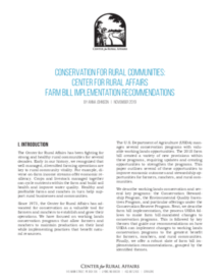Farm and Food
The Center for Rural Affairs has been fighting for strong and healthy rural communities for several decades. Early in our history, we recognized that well-managed, diversified farming operations are key to rural community vitality. For example, diverse on-farm income streams offer economic resiliency. Crops and livestock managed together can cycle nutrients within the farm and build soil health and improve water quality. Healthy and profitable farms and ranches in turn help support rural businesses and communities.
Since 1973, the Center for Rural Affairs has advocated for conservation as a valuable tool for farmers and ranchers to establish and grow their operations. We have focused on working lands conservation programs that allow farmers and ranchers to maintain production on their land while implementing practices that benefit natural resources.
The U.S. Department of Agriculture (USDA) manages several conservation programs with valuable working lands opportunities. The 2018 farm bill created a variety of new provisions within these programs, requiring updates and creating opportunities to strengthen the programs. This paper outlines several of these opportunities to improve economic outcomes and stewardship opportunities for farmers, ranchers, and rural communities.
We describe working lands conservation and several key programs: the Conservation Stewardship Program, the Environmental Quality Incentives Program, and particular offerings under the Conservation Reserve Program. Next, we describe farm bill implementation, the process USDA follows to make farm bill-mandated changes to conservation programs. This is followed by key themes that guide our recommendations on how USDA can implement changes to working lands conservation programs to the greatest benefit for farmers, ranchers, and rural communities. Finally, we offer a robust slate of farm bill implementation recommendations, grouped by the identified themes.


